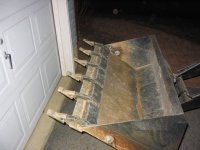As Scott indicated to me, it's the potential for over-ambitious filling/loading with heavy materials, not the action of digging itself, that can result in the deformation of the larger L/M bucket as compared with the smaller rock bucket.
The capacity of the L/M bucket is 2X that of the rock bucket (10 cu ft vs 5 cu ft). To "equalize" the L/M and rock bucket in terms of withstanding loads, one would have to fab the L/M of heavier stock, not the same stock as is currently done. Some owners have reported sagging of the floor of the L/M bucket, as mentioned by MR here. Since the capacity of the rock bucket is smaller to begin with, the operator simply can't "overload" it, i.e., there is a built-in fail-safe. I guess if anyone was loading uranium with the rock bucket that might be a problem /forums/images/graemlins/grin.gif
Digging/ripping involves another set of forces on a bucket. When used for digging as opposed to loading, a toothbar gets its primary strength from the cutting edge of the bucket. (That's why the bar mfrs all stress to the buyer to be ceratin your bucket edge is in good shape before installing a bar.) The edges of the L/M and rock buckets are fabbed of the same stock material, and the L/M is only 3" wider than the rock bucket (48" vs 45" for the 422/425). Hence, the forces exerted on the two bucket edges should not be substantially different, especially if the operator follows the guidelines nicely outlined by KentT earlier in this thread. It probably comes down to the old adage of <font color="green">"Use, but don't abuse."</font>
